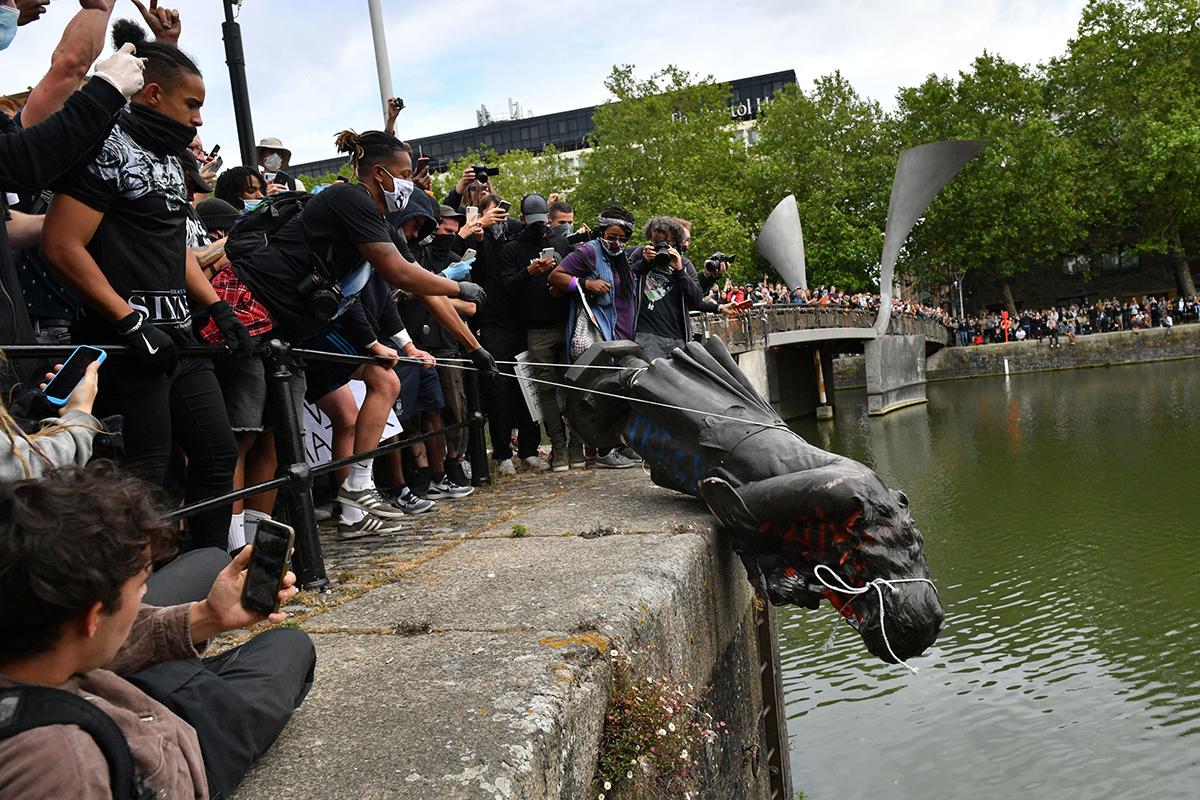The toppling of colonial statues is easy. What replaces them is more complex
During the reformation in the 16th century, religious icons were destroyed on an unprecedented scale, under the Protestant view that they were idolatry and therefore sinful, writes Melissa Baksh

The tearing down of the statue of slave trader Edward Colston in Bristol has been divisive, sparking protests and counter-protests around the country.
Many celebrate the act of tearing down colonial art, whereas some condemn it, calling it “lawless destruction”. It forces us to ask important questions around the purpose of art, and why people seek to destroy it. Though iconoclasm is inherently destructive, it can signify a defining moment in history that can ignite social change. The toppling of Colston therefore signals a turning point in how Britain confronts its colonial past. Rather than an erasure of history, it is a confrontation with it – and a call to end public displays that celebrate oppression and violence.
This debate sits within a long history of British iconoclasm. During the reformation in the 16th century, religious icons were destroyed on an unprecedented scale, under the Protestant view that they were idolatry and therefore sinful. Images carried such potency for the country’s leaders that their destruction was one of the main tools used in the fight for the dominant faith at the time.
Moving forward, in 1914, Diego Velazquez’s Rokeby Venus was attacked as it hung in the National Gallery. Suffragette Mary Richardson slashed the painting, which shows a nude woman reclining, in protest against the arrest of Emmeline Pankhurst. The high-profile attack of a painting that objectified women at a time when women were not able to vote thrust the Suffragettes’ movement further into the public eye. Richardson commented that as an art student herself, it was difficult for her to damage the painting, but she had been forced to do so by the government’s indifference to the Suffragist cause.
This speaks directly to the conflicted nature of iconoclasm as a tool for social change, and the following comment from Richardson seems to echo current sentiments of protesters who are using violence against property to draw attention to the Black Lives Matter movement: “You can get another picture, but you cannot get a life, as they are killing Mrs Pankhurst.”
Due to its destructive nature, iconoclasm should never be celebrated in its own right. Michael Rakowitz’s The Invisible Enemy Should Not Exist in Trafalgar Square poignantly critiques the destruction and looting of art works during the Iraq war, in which over 7,000 objects were lost. However, what occurred in Bristol was undeniably healing, and a cathartic moment for many, as the statue itself embodied violence against black people. Such themes are explored in Kara Walker’s 2019 Fons Americanus, a public sculpture in the Tate Modern that inverts the notion of honouring monuments that celebrate a history of violence.
Iconoclasm also raises questions around the purpose of art in public spaces. Alison Yarrington, historian of British art and sculpture, suggests that one way to tackle our difficult past is not to erase it but, through new public art, and to engage directly with it. For example Yinka Shonibare's Ship in a Bottle, previously in Trafalgar Square, considers the legacy of British Empire and the multi-cultural society it has produced. Rather than the physical destruction of statues and monuments, as Yarrington says, we should work with and consult communities to create new artworks for public spaces that counter the contested histories and heritages that the Colston statue embodies.
Labour MP Zarah Sultana, a descendent of Pakistani migrants to the UK asked, “[is it] right that black Britons have to walk in the shadows of statues glorifying people who enslaved and murdered their ancestors?” The effects of historical trauma related to slavery still persist today. A study by biologist Michael Skinner found that parents’ trauma can be passed down genetically to their children through generations, therefore intergenerational trauma is not only a psychological concept, but has a lasting, physical impact. Therefore, violence is not only seen in the statue, but is undoubtedly felt – its weight as heavy as the bronze that lay in Bristol waters.
With these racist symbols venerated in our cities and our communities, how can any of us breathe easy? There must be more education and greater sensitivity around art works and monuments that glorify violence and oppression. Bristol mayor Marvin Rees says it is “highly likely” that the statue of Colston will end up in a museum. This poses wider questions around the role of cultural institutions and their responsibility to educate people on our shared history. Museums are not separate from colonial legacy and it is time they become more transparent about their part in it, and take an active approach to educate people on such matters.
As William Faulkner said: “The past is never dead. It’s not even past.” How a city chooses to represent its history sends a clear and distinct message to its present, and also future, communities. In London, the wheels of change are in motion, it seems. Sadiq Kahn has ordered a review into monuments that glorify slave traders, and the statue of 18th-century slave-owner Robert Milligan has been removed from London’s Docklands. There is reignited debate for the statue of Cecil Rhodes to be taken down from Oriel College at the University of Oxford.
The potency of these symbols can no longer be denied, and if black lives really do matter in the UK, then Rhodes must fall, and so must the rest. Now Colston’s toppling has provided a deeply cathartic moment, the question of what will replace him is, perhaps, more complex.
Join our commenting forum
Join thought-provoking conversations, follow other Independent readers and see their replies
Comments